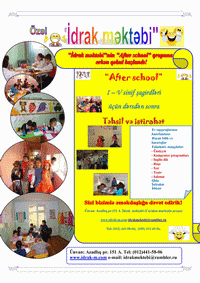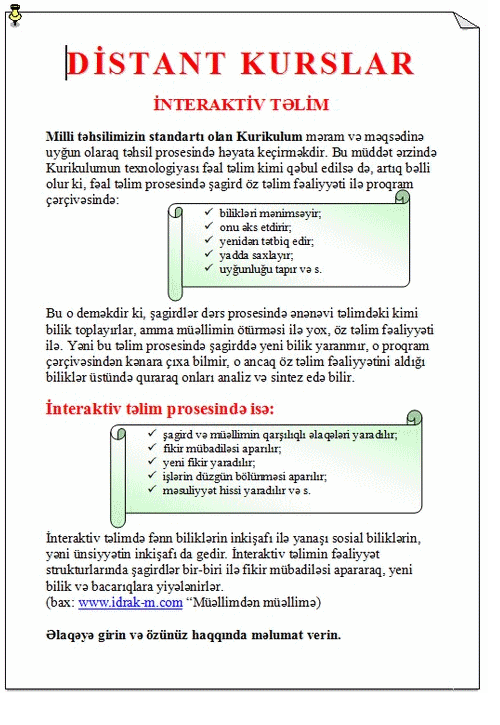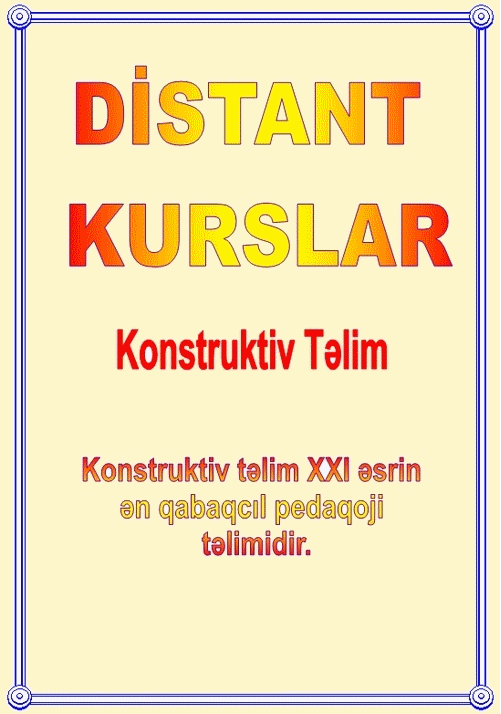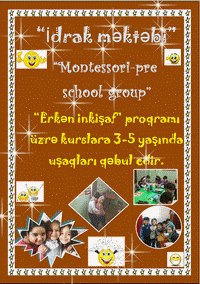Constructive approach in the education
Tarana Aliyeva, Art Gymnasium of the Republic of Azerbaijan
e-mail : terane .aliyeva 1963@mail.ru
Yagut Azimzade, Art Gymnasium of the Republic of Azerbaijan
e-mail :azimzade.yaqut@gmail.com
http://www.icits2012.org/
Abstract:
This article focuses on the constructive approach in training and development of intelligence
At the present-day world for the development of the modern society creative, independent, free-minded and progressive individuals are to be brought up and trained. In order to achieve this objective the fundamental reforms are carried out in the education system in Azerbaijan Republic. Since 2008, application of the new educational standards — Curriculum system activated this transition process. These changes are not able to develop the students’ creativity, independency, free thinking. Thinking, thoughts could be developed if there is sequence works on the knowledge.
During the work when one knowledge transforms into another, by quality the new knowledge is formed
This development is based on the cognitive theory of J.Piaje.
Uzing the constructive training mechanisms created by the teacher Ms. Fatma Bunyatova on the basis of the Piaje theory, we have started to build the new method of lessons training. The constructive training by Fatma Bunyatova is teaching the students of the interactive activity to learn how to gain the by the way of thinking about the knowledge. Such methods of the subjects consist of the new, sequence and related to each other semantic and logical tasks. One achieving application of this technology together with the ICT training to the education procedure within the short time will be able to practically reveal the development of the student thinking.
keywords
constructive learning, development of intelligence, operations, semantic tasks, logical setting, active learning, interactive learning
At the present-day world for the development of the modern society creative, independent, free-minded and progressive individuals are to be brought up and trained. In order to achieve this objective the fundamental reforms are carried out in the education system in Azerbaijan Republic. Since 2008, application of the new educational standards — Curriculum system activated this transition process (4). The traditional method of teaching had been replaced with the new style actively trained teaching lessons. At the ICT-based lessons the students are busy with the training activity, gaining the knowledge trying to find the best solution of the problem. At the active training the teacher attracts the students’ attention to the subject matter, as well as in order to make the lesson more interesting pays more attention to the motivation part of the lesson. The result of the motivation usually consists of the finding the subject what students are going to study. Formulation of the problem and its solution will be started after that. During the classes working in the active training period, we could see its difference from the traditional training. The result of this training is the fact that the students are more active at the lessons; they are keen to learn more the knowledge passed by the teacher, owning the skills to work in groups, thus becoming socialized. This means the formation of good management skills of the students. However, these changes do not satisfy the demands of the time. These changes are not able to develop the students’ creativity, independency, free thinking. Thinking, thoughts could be developed if there is sequence works on the knowledge. During the work when one knowledge transforms into another, by quality the new knowledge is formed. Speaking by the program language, if today we study 3 class materials, by conducting the logical operations the obtained knowledge will become the learning materials of the further classes. The present education conception of the present-day world education sphere considers the development of thinking as the main object of the students’ intellectual development.
This development is based on the cognitive theory of J.Piaje.(1)
The context, content, volume and defining the system of the educational materials of cognitive development is the important psycho-pedagogical problem. According to him, for the development of the students’ thinking the systematic semantic battery tasks are to be created on different subjects. (Piaje)
Using the constructive training mechanisms created by the teacher Ms. Fatma Bunyatova on the basis of the Piaje theory, we have started to build the new method of lessons training. The constructive training by Fatma Bunyatova is teaching the students of the interactive activity to learn how to gain the by the way of thinking about the knowledge. Such methods of the subjects consist of the new, sequence and related to each other semantic and logical tasks (2). One achieving application of this technology together with the ICT training to the education procedure within the short time will be able to practically reveal the development of the student thinking.
According to Bunyatova’s Constructive training the development has to pass these ways:
The creation and expansion of the thinking;
Transformation of the thinking into the knowledge;
Application of knowledge by the skills;
Establishment of new knowledge from the knowledge.
We would like to give some fragments of Mathematics and the Mother Tongue classes leading to this development (4).
The lesson of the constructive training starts by analyzing the semantic meaning of the given subject and in case if the word is loan-word, then its dictionary meaning will be explained.
Searching for the meaning of the subject, for example, in the Mathematics class, studying the «Network of the coordinate» subject,(3) the word co-ordinate of the Latin origin will be explained: co- means together and ordinate means the network. (In other words, it means the regulation of one object from the both sides).
Then in order to analyze and bring out the meaning of the word «network» the students are asked the following question:
— Coordinate means the regulation of one object from the both sides. But what do you think what does network mean? How do you understand this word?
After the interactive team discussion the answers got brought the different semantic meaning of this word. In other words, it became the not individually discussed issue, but the ideas of all the students were discussed. The variety of the responses (network, distribution, network is the window) makes the meaning to be widened. After creating the meaning of the network of the coordinate, this thinking has to be converted into the concrete knowledge.
The questions of such conversion usually are the followings:
— Find the coordinate of the object. Place the couples into 7.3, 8.4, 6.4 coordinates network. Such type of the tasks serve to create the particular knowledge.;
The question for developing the skills of application of the knowledge gained by the students was as follow:
— If the multiplication of the couples is 35; 25; 12; and 19 which pairs do they consist? This is a logical condition and according to this condition the students are finding out the combinations by coming to this conclusion and by analyzing (5)
Replacing one knowledge with another one creates the new knowledge by its quality, i.e. the knowledge learned in the future. To create the new knowledge the following steps are to be taken:
First of all, we would like to note that the coordinate network in the textbook is shown as the horizontal and vertical axis. The axis are not indicated with X and Y asterisks. Here the new knowledge is created by showing the signs by the soft transition. This new knowledge integrates the future knowledge into the today’s knowledge and serves for the creation of the scheme of integrity in the thinking of the student.
The following conditional question is arisen for the students:
— If we read vertical axis as Y and horizontal as X (x and y are unknown numbers in Mathematics), then how shall we shortly mark this network?
Despite the fact that the answers are different, they usually are correct in accordance with conditions.
After the concept of Y is vertical and X is horizontal is created in the students’ thinking, in order of this conception to be kept in the mind of the student the following creative task will be given to them:
Put any desired numbers instead of X and Y and place them on the coordinate network.
When the students carry out this tasks in teams, their thinking become deeper, wider, because here every student share their opinions. Presentation of the team work in the class showing the ways of setting the various networks means to show the students different ways of solution. By these methods working jointly each student will get an advantage of such solutions individually, as well as in team.
When the training goes this way, the students gradually begin to build this way of thinking in their own thinking. Indicators of this are justification of their responses, the logical formulation of the questions, the transition of one knowledge into the new one, a unique way to solve the tasks, and other non-regular basis, etc.
The new constructive approach of the new thinking development had been applied in the Mother Tongue classes as well. For example, after coding the parts of speech in the language classes as the follows:
(1 — noun, 2 — adjective, 3 – numeral, 4 — pronoun; 5 – verb and 6 — pronoun)
there will be full meaning of the parts of speech created in the students’ thinking. If the subject of the lesson is the “adjective”, then the relation of the “adjective” with the other parts of speech will be found out. Then the new knowledge with the logical questions related to the adjective will be created.
By this method the teacher does not pass the new knowledge to the students, creates the condition and asking the logical questions, on the basis of which the students create their own knowledge themselves.
This new constructive approach in the education is aimed to develop a standard quality program. The thinking developed by this method gradually changes the tools of this into their own thinking tools.
The thinking skill of the individual, mobility of their knowledge, expressing their knowledge to gain the new knowledge, being sociable are the main knowledge and skills of the XXI century we live. And today, this issue should be one of the main problems to be solved by each and every teacher.
BIBLIOGRAPHY
1.F. C. Bunyatova, Konstruktiv təlim. Mahiyyəti, prinsip, vəzifələr və dərslərdən nümunələr.
Bakı, 2008
2.Əbdül Əlizadə “İdrak prosesləri və hisslər” (psixopedaqoji məsələlər) Bakı-2006
3.Naima Qəgrəmanova. 3 sinif riyaziyyat 2011 Bakı
4.http://www.kurikulum.az/index.php?option=com_content&view=article&id=210&Itemid=116&lang=az
Baxış: 4603






